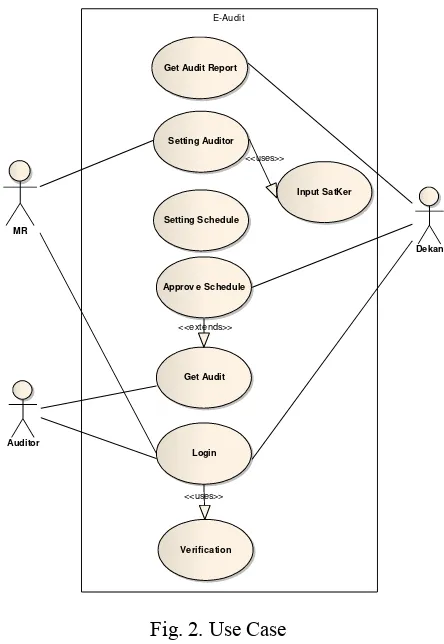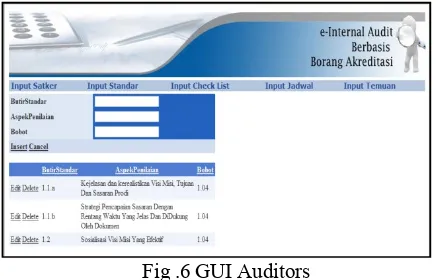©Universitas Bandar Lampung 2013
The E-Internal Audit ISO 9001:2008 Based on Accreditation Form
Assessment Matrix in Study Program for Effectiveness of Monitoring
Accreditation
Marzuki#1, Maria Shusanti F#2and Andala Rama Putra.#3
#
Department of Informatics Engineering , Faculty of Computer Science , Bandar Lampung University Za. Pagar Alam. St. No. 26 Labuhan Ratu Bandar Lampung, Indonesia
1
(Received June 2013, Accepted November 2013)
Abstract-Accreditation is one of the forms of external quality guarantee system; it is a process that used in authorized institution in giving formal recognition that an institution has an ability to do certain activity. On the preparation process there are many things have to be done by study program by using internal audit in periodic time. Internal audit is an independence activity, objectivity, and consultatively which is designed to increase the organization’s operation. This study will specifically focus on internal process audits in preparation for accreditation of Study Program of Information Engineering at Bandar Lampung University, through conducting monitoring directly that can be accessed by some units in a management system. The guidelines and standards for internal audit issued by one of several organizations ISO, the quality management system ISO 9001: 2008, one of the requirements must be fulfilled is conducting periodic internal audits. This standard is good when applied in the preparation for the accreditation process, and accreditation assessment matrix as a guide in conducting internal audits.
Keywords: Accreditation, ISO 9001:2008, Internal Audit
I. INTRODUCTION
Accreditation is a form of external quality warranty system; it is a process that used in authorized institution to give formal recognition that an institution has the ability to perform certain activities.
Thus, accreditation protects the public from fraud by parties who are not responsible. The characteristics of accreditation is the hallmark
assessment by experts from outside institutions (external peer reviewers), and conducted by volunteers, for college organized a course of study. This activity begins by conducting a self-evaluation (self-evaluation) of the various / components of inputs, the process and product from the study program that want to be accredited must submit its report to the accredited institution.
In accreditation preparation process there are many things have to be done by the study such as conduct audit the program. Audit activity is an independent, objective and consulting designed to add value and to improve an organization's operations [1]. This helps the organization to achieve its purpose systematically, disciplined approach to evaluate and improve the effectiveness of risk management, internal control, etc. But in the audit process of preparation for accreditation there are some obstacles [2] such as the company did the audit only as the mandatory, without any direct monitoring that can be accessed by multiple units within the management system. Other issues of monitoring and updating of data from internal audit, which has been done with paper base, so that the consumption of paper for every invention and audit results and the report is presented in the form of printed reports.
The guidelines and audit standards are given by several organizations, one of them is ISO, on the quality management system ISO 9001: 2008 one of the requirements that must be fulfilled internal audits periodically[3],[4]. This standard is good when applied in the preparation of the accreditation process, accreditation assessment matrix as a guide in conducting audit.
audit implementation into electronic form, where updating the data, reporting and the system process is done by website media. Thus, it can increase the effectiveness of audit activity monitoring, updating data faster and more efficient in the preparation of reports.
II. PROCEDURE
This observation formulates the problem how to compose an e-Internal Audit ISO 9001:2008 accreditation forms-based matrix assessment study for effectiveness monitoring program of accreditation with the aims to:
1. Testing the mapping between the standard ISO 9001:2008 and form accreditation of bachelor degree study program.
2. ISO 9001:2008 audit evaluates the matrix-based assessment accreditation forms with monitoring effectiveness assessment study program accreditation forms.
By implementing the ISO 9001:2008 standard accreditation forms study program and the evaluation use ISO 19011:2005 and the function of monitoring the effectiveness of accreditation, which is described in the internal model of the integrated audit of ISO 19011:2005, ISO 9001:2008 & BAN PT as follow:
MODEL INTEGRATED INTERNAL AUDIT BETWEEN ISO 9001:2008 BAN PT
Fig.1 Model integrated internal audit ISO 19011:2005 ISO 9001:2008 & BAN PT
III. TECHNICAL ANALYSIS
To analysis the data in this study, we are going to analyze by comparisons methods which can be used to see the difference in an experiment output. If it
has an impact on the experimental results (experimental purposes), then we will determine the increment by the following equation:
vt = i the audit process which is commonly used in quality management system. The actor's involved with the system shown in Figure2.
Fig. 2. Use Case
management member and also as the top/main management at faculty level. While the auditor is an actor who performed an audit or as actors who carry out the whole process in study program level.
Programming algorithm on e-audit process flow depicting the big outline on the application audit that listed on the pseudo code that is referred to others. Globally pseudo code application in this observation is illustrated in Figure 3.
Pseudo-code: Audit
Narrativ: Computasi e’audit berdarkan matrik penilaian
Input: Tabel auditor, satker,standar,temuan dan jadwal
Output: Temuan Rinci
(1) START
(2) Input User, Password
(3) Verification
(4) If User equal “MR”
Load MRPage Set Satker Set Auditor Set Jadwal Else
If User equal “Dekan” Load DekanPage If jadwal.equal approve Jadwal equal true Else
Jadwal equal false End if
Get audit Report Else
If User Equal “Auditor” Load AuditorPage
Select Audit Number Input nilaiCapai
Skor=Skor+Nilaicapai*bobot Input Temuan, Koreksi Save Temuan Rinci End if
End if End if
(5) END
V. THE IMPLEMENTATION
This observation uses the implementation of software e-audit:
1. GUI Login
GUI login is interface that is used for validation of the parties has the right to be able to go in and be able to use all the facilities that exist in the system.
Fig.3: GUI Login
2. GUI workgroup
GUI workgroup is interface that is used to provide input ideas to system-related parties, on this page, just fill the system on administrator membership such as number, name and unit of work.
Fig.4. GUI Satker
3. Standard GUI
Standard GUI is the interface to give information to the system about every standard that available on the standard accreditation forms and also the weight of scoring on every standard that has been taken from the accreditation assessment matrix.
4. GUI Auditor
GUI Auditor is the interface to form auditor groups who is involved with each corresponding positions and determined by the representative management.
Fig .6 GUI Auditors 5. GUI Schedule
GUI schedule is used to provide audit schedule which has to be done based on agreement between the auditor and other parties whom will be audited.
Fig .7 GUI Schedule
6. GUI Findings
GUI Findings is interfacing that give suggestion to the system because of invention that available on audit process.
Fig.8 GUI Findings
7. Detailed Findings GUI
Detailed Findings GUI is the interface that details the findings of the audit process on the level of each item audited standards. By performing calculations based on the existing achievements, calculated based on the weight of each item in accordance with standard evaluation metrics.
Fig.9. Detailed Findings
8. GUI Print Report
Interface is displayed to print the audit report.
Fig 10. Print Reports
TABLE 1. IMPLEMENTATION I
98 7.2.2 listed 3 1.88 5.64
99 7.3.1 listed 4 1.88 7.52
100 7.3.2 listed 4 1.88 7.52
Total 246.3
Final Score 184.7
The analysis of the research is using the method of comparisons that can be used to test the suitability of the difference in an experiment on the output of a process. From the comparison between the results of the Implementation I and II (Table 1 and Tabel 2), it shows that there is a difference (Tabel 3).
TABLE 2. IMPLEMENTATION II
98 7.2.2 listed 4 1.88 7.52
99 7.3.1 listed 4 1.88 7.52
100 7.3.2 listed 4 1.88 7.52
Total 335
Final Score 251.3
TABLE 3. COMPARASION SCORE Description Implementation I Implementation II
Total Score 246.3 335
Final Score 184.7 251.3
X = Implementation II - Implementation I (1)
Increment = X /Implementation I * 100 (2) Then the comparison we get:
X = 251.3 -184.7
= 66.6
Increment = 66.6/184.7 * 100 = 36.058%
So, there is some improvement between implement-tation I and implemenimplement-tation II.
Fig 11. Comparison Charts
VI. CONCLUSION
From the results of the implementation I and implementation II, the observation shows some important result which can be formulated on the conclusion, as follow:
1. Improved assessment (final grade) in this observation showed an increment in the value of the accreditation about 36 058%.
2. The application of e-assessment matrix accreditation forms can increase the effectiveness of monitoring accreditation of study program.
REFERENCES
[1] Dudek-Burlikowska, M. (2010). Aspects Of Improving The Organization Directed To The Quality.International Scientific Journal.
[2] Durai Anand Kumar, D. V. (2011). A Study on ISO 9001 Quality Management System Certifications – Reasons behind the Failure of ISO Certified Organizations. Anna university of Technology, Coimbatore,Tamil Nadu.
[3] Michalska-Ćwiek, J. (2009). The Quality Management System in Education -Implementation and Certification.”, Institute of Engineering Materials and Biomaterials, Silesian University of Technology.
[4] Poza, A. S. (2009). Implementing a Functional ISO 9001 Quality Management System in Small and Medium-Sized Enterprises. Volume

